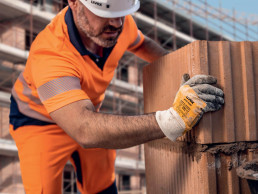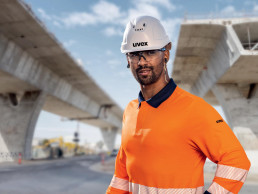Safety on construction sites is an extremely important goal for everyone involved in building projects. Dangerous work may be carried out on construction sites, accidents on site are often serious and the health and safety of numerous employees is at stake. In this article, uvex will therefore identify important factors for safety on construction sites.
Which legal regulations apply to safety on construction sites?
In order to implement occupational safety measures on construction sites, the German legislature issued the Construction Site Ordinance (BaustellV). This specifically defines the obligations and responsibilities of the employer, site manager and construction site coordinator. The aim is to implement occupational safety measures on construction sites at every step. The health and safety protection plan, which is drawn up by the appointed health and safety coordinator (SiGeKo), plays an important role.
Further important safety regulations can be found in the Rules for Occupational Safety and Health on Construction Sites (RAB), which were established by the Committee for Safety and Health on Construction Sites (ASGB). These safety notes for construction sites are based on Section 4 of the Occupational Health and Safety Act (ArbSchG) and must be taken into consideration by the building contractor and the health and safety coordinator (SiGeKo).

Who monitors compliance with safety regulations on construction sites?
Compliance with occupational safety regulations on construction sites is checked by safety specialists within the company and also by agencies appointed by the German federal states: trade supervisory boards, authorities for occupational health and safety or the regional authority. The statutory accident insurance for the construction industry and construction-related services in Germany (Berufsgenossenschaft Bau) monitors documented information on construction processes such as the services provided by contracted maintenance groups and logging hourly work. Advance notice of an inspection is usually given.
Since notifiable occupational accidents and occupational diseases must be reported to the Employer’s Liability Insurance Association for the Construction Industry, it keeps statistics on them: According to the Employer’s Liability Insurance Association for the Construction Industry, there were 0.4 % fewer occupational accidents in the construction industry in 2021 than in 2020 (from 103,970 to 103,525). The number of fatal accidents at work also decreased in 2021 (from 97 to 85 employees). On the other hand, the number of commuting accidents increased in 2021 compared to 2020 (from 7,723 to 8,808).
Which factors play a role in safety on construction sites?
A combination of many factors plays a role in safety on construction sites. Potential dangers or injury risks can be the result of errors at work, unsecured hazard areas, equipment that is faulty or not maintained and a lack of knowledge or awareness.
Schutzkleidung: persönliche Schutzausrüstung auf der Baustelle
In its statistics published in 2022, the Federal Institute for Occupational Safety and Health states that the most frequently reported occupational diseases in 2020 were skin diseases and noise-induced hearing loss, in addition to the pandemic-related increase in infectious diseases. According to the statistics of the BG Bau, diseases of the lumbar spine are in third place in 2021. Unfortunately, the reported suspected cases of occupational diseases increased in 2021 (from 15,821 to 16,492). The good news is that you can prevent a wide range of occupational diseases and accidents with effective personal protective equipment (PPE). PPE refers not only to robust protective clothing, but especially to the protection of body parts and functions. You can get an overview of uvex’s occupational safety products on our “Construction” page. uvex is the expert for personal protective equipment and will comprehensively equip you with:
- Eye protection: safety glasses (with prescription), visors
- Respirators: FFP1–FFP3 masks
- Hearing protection: hearing protection earplugs, earmuffs, otoplastics (customised hearing protection)
- Head protection: safety helmets for construction sites
- Safety gloves: gloves protect against mechanical injuries, chemicals and cutting injuries, depending on the model.
- Safety shoes: class 1 to 3 safety shoes for various uses.
- Work clothing for construction sites: high-visibility clothing for easier recognition on construction sites and robust workwear and disposable safety overalls for work involving chemicals.
What’s special about uvex’s protective equipment is its customisability: uvex can customise for you, for example, safety shoes with orthopaedic insoles, prescription safety spectacles, computer glasses and hearing protection otoplastics with ear canal impression. Get an overview of the different uvex PPE product categories!
uvex has also developed safety products specifically for the construction sector so your employees are optimally protected against hazards on the construction site. If you work in the interior construction, building construction or civil engineering sectors, go to the category pages, select your occupation and find quality personal protective equipment in the areas listed above. Some of uvex’s PPE products comply with the provisions set out by the statutory accident insurance for the construction industry and construction-related services in Germany (BG Bau) and may be subsidised by them. Take a look at our uvex construction product catalogue of uvex protective clothing for construction site safety! If you have questions or would like advice, please contact our uvex construction experts using the contact form.

Conduct on construction sites
As there can be many employees working on a construction site and numerous tools and materials in use, clear arrangements and good coordination of tasks are essential factors. The health and safety coordinator will discuss with the building contractor the processes and ways of working on the construction site. They will also take care of arrangements between the building contractor and the workers. Their health and safety protection plan also forms a basis for the risk assessment of the construction site. These tasks play a significant role in ensuring safe collaboration on construction sites.
As well as good coordination of work processes on construction sites, clear arrangements between employees and in-depth instructions for tasks also significantly contribute to construction site safety. Important safety measures for the construction site and rules of conduct relating to construction work should also be communicated clearly in order to avoid hazards or workplace accidents that are a result of a lack of awareness or knowledge.
Marking and signage on construction sites
Professional marking and securing of construction sites are also important factors for construction site safety. Make sure that your site is sufficiently secured and marked with construction fences and warning signs for passers-by (construction site security). This also applies within the construction site for areas where there is a danger of falling such as pits, scaffolding edges and high work areas as well as for machines with potential hazards. In these cases, primary and secondary fall protection equipment such as scaffolding, side protection panels, fall guards and fall arrest devices should be used as protection.
Accident prevention signs are of great importance for employees on a construction site, as they warn them about dangerous areas and give instructions on how to act accordingly. The Committee for Workplaces has also set regulations and minimum brightness levels for illumination on construction sites.
Emergency response plan on construction sites
Well-thought-out emergency plans for hazardous situations that everyone is aware of also play an important role in safety on construction sites. Examples include first aid measures for employees, actions for recognising and extinguishing fires and keeping traffic and emergency escape routes clear.
How are dangers on construction sites identified?
In order to avoid dangers on construction sites, they must first be identified. The Occupational Health and Safety Act therefore stipulates that work and working conditions on construction sites must be checked for potential hazards. The aim is to identify safety flaws and inadequate equipment as well as other safety risks in good time and to prevent any resulting dangers. The risk assessment for construction sites is carried out by the health and safety officer. The construction site risk assessment is based on the health and safety protection plan for construction sites, which is drawn up by the coordinator. The more detailed and precise the risk assessment is, the lower the risk potential from the outset.
Who is responsible for safety on construction sites?
Given construction site safety regulations and accident prevention regulations for construction sites as well as other safety measures, an important question arises: who is responsible for safety on construction sites? According to the German Federal Institute for Occupational Safety and Health, the employer, health and safety officers, the building contractor, the site manager, the architect and also the above-mentioned coordinator are all responsible for occupational safety on construction sites.
The health and safety officer carries out the risk assessment, ensures the workplace is safe, organises work processes in accordance with safety regulations and provides safe working equipment as well as the necessary protective equipment. The ultimate responsibility for the construction project lies with the building contractor: they must apply the construction site regulations and appoint the coordinator. This health and safety coordinator then has the task of implementing the safety measures. The head of the company decides on the occupational safety measures in accordance with the Occupational Health and Safety Act. According to the Occupational Health and Safety Act, the employer is obligated to inform their employees about any safety measures taken in a comprehensible way. uvex supports construction companies at this point with its uvex academy occupational safety training. The training covers personal protective equipment, measuring techniques and laser protection.

Safety on construction sites – conclusion
As this article has made clear, there are many different factors that contribute to safety on construction sites. The site manager and the health and safety coordinator should have an overview of the entire construction site, ensure compliance with safety regulations and coordinate work processes on the construction site. However, construction site safety also depends on all employees being kept informed about occupational safety measures, their tasks and the work processes on the construction site. If you want to deepen your understanding of the subject of “Occupational health and safety on building sites”, have a look at our blog post! We have also published a blog post on the subject of “Sustainable construction”.